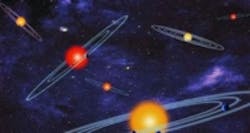NASA’s Kepler spacecraft discovers 715 new planets
NASA’s Kepler mission has announced the discovery of 715 new planets that orbit 305 stars, revealing multiple-planet systems similar to our solar system.
The vast majority of these planets (95%) are smaller than Neptune, a planet that is almost four times the size of Earth. This discovery marks a significant increase in the number of known small-sized planets similar to Earth than previously identified planets outside of our solar system, according to a NASA press release.
Kepler was designed by NASA and Ball Aerospace & Technology Corp. to monitor more than 100,000 stars in the Milky Way galaxy. Kepler’s photometer is a 0.95 meter aperture, 12° diameter field-of-view Schmidt telescope with a 1.4 meter primary mirror. Kepler’s focal plane array of 42 e2v backside-illuminated CCD detectors—each of which is a 50 x 25 mm CCD with 2,220 x 1,024 pixels—comprises a 95 MPixel array. The CCDs are back-thinned for high spectral response across the visible and near-infrared range and feature a 3 MHz read-out rate. The CCDs are not used to take sharp pictures; instead, the images are intentionally defocused to about 10 arc seconds to improve the photometric precision.
The photometer has a spectral range from 400 nm to 850 nm and data from the individual pixels that make up each star of the 100,000 stars are recorded continuously and simultaneously. Data is stored on the spacecraft and transmitted to the ground about once per month.
NASA explains that the multiple-planet systems are fertile grounds for studying individual planets and the configuration of planetary neighborhoods, which provides clues to planet formation. Of the 715 planets discovered, four of them are less than 2.5 times the size of Earth and orbit in their sun’s habitable zone, defined as the range of distance from a star where the surface temperature of an orbiting planet may be suitable for life-sustaining liquid water. One of the planets in particular, named Kepler-296f, orbits a star half the size and 5% as bright as the sun. This planet is twice the size of Earth, but NASA scientists are unsure whether the planet is a gaseous world with a thick hydrogen-helium envelope, or a water world surrounded by a deep ocean.
With the discovery of these 715 new planets, the total confirmed count of planets outside of our solar system is approximately 1,700.
View the NASA press release.
Also check out:
(Slideshow) Robots and research: Eight examples of innovative imaging applications
European Southern Observatory creates first weather map of brown dwarf
Australian astronomers discover oldest known star in the Universe
Share your vision-related news by contactingJames Carroll,Senior Web Editor, Vision Systems Design
To receive news like this in your inbox, click here.
Join our LinkedIn group | Like us on Facebook | Follow us on Twitter | Check us out on Google +
About the Author

James Carroll
Former VSD Editor James Carroll joined the team 2013. Carroll covered machine vision and imaging from numerous angles, including application stories, industry news, market updates, and new products. In addition to writing and editing articles, Carroll managed the Innovators Awards program and webcasts.
